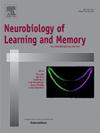含有glua1的AMPA受体是稀疏记忆印迹形成所必需的。
IF 1.8
4区 心理学
Q3 BEHAVIORAL SCIENCES
引用次数: 0
摘要
记忆的形成依赖于选择性地将神经元集合招募到被称为记忆印痕的电路中,这代表了记忆的物理基础。这些集合的稀疏编码对于记忆的特异性和效率至关重要。AMPA受体(AMPAR)亚基,特别是GluA1,在突触可塑性中起着核心作用,突触可塑性是记忆编码的基础。本研究探讨了GluA1表达如何影响神经元向记忆印迹的募集。使用GluA1基因敲除小鼠、局部敲除模型和情境恐惧调节范式,我们评估了GluA1在记忆形成和印迹稀疏性中的作用。GluA1KO小鼠表现出短期记忆保留受损,但保留了24小时上下文记忆。尽管如此,这些小鼠在海马神经元中显示出直接早期基因Arc的表达增加,表明有更广泛的印迹网络。电生理分析显示,与Arc表达无关,glua1缺陷神经元的突触强度降低。局部GluA1基因敲除证实了GluA1缺陷增加了神经元向印迹的募集,破坏了在野生型小鼠中通常观察到的稀疏编码。这些发现表明,含有glua1的AMPARs限制了印迹的大小,确保了有效记忆编码的神经元的选择性招募。通过调节突触可塑性,GluA1促进了记忆回路的编码和大小。这项研究强调了GluA1在维持稀疏印迹形成中的关键作用,并提供了在突触组成改变的情况下记忆缺陷的机制。本文章由计算机程序翻译,如有差异,请以英文原文为准。

GluA1-containing AMPA receptors are necessary for sparse memory engram formation
Memory formation depends on the selective recruitment of neuronal ensembles into circuits known as engrams, which represent the physical substrate of memory. Sparse encoding of these ensembles is essential for memory specificity and efficiency. AMPA receptor (AMPAR) subunits, particularly GluA1, play a central role in synaptic plasticity, which underpins memory encoding. This study investigates how GluA1 expression influences the recruitment of neurons into memory engrams. Using global GluA1 knockout (GluA1KO) mice, localized knockout models, and contextual fear-conditioning paradigms, we evaluated the role of GluA1 in memory formation and engram sparsity.
GluA1KO mice exhibited impaired short-term memory retention but preserved 24-hour contextual memory. Despite this, these mice displayed increased expression of the immediate early gene Arc in hippocampal neurons, indicative of a denser engram network. Electrophysiological analyses revealed reduced synaptic strength in GluA1-deficient neurons, irrespective of Arc expression. Localized GluA1 knockout in the hippocampus confirmed that GluA1 deficiency increases neuronal recruitment into engrams, disrupting the sparse encoding typically observed in wild-type mice.
These findings demonstrate that GluA1-containing AMPARs constrain engram size, ensuring selective recruitment of neurons for efficient memory encoding. By regulating synaptic plasticity, GluA1 facilitates both the encoding and size of memory circuits. This study highlights the critical role of GluA1 in maintaining sparse engram formation and provides insight into mechanisms underlying memory deficits in conditions where synaptic composition is altered.
求助全文
通过发布文献求助,成功后即可免费获取论文全文。
去求助
来源期刊
CiteScore
5.10
自引率
7.40%
发文量
77
审稿时长
12.6 weeks
期刊介绍:
Neurobiology of Learning and Memory publishes articles examining the neurobiological mechanisms underlying learning and memory at all levels of analysis ranging from molecular biology to synaptic and neural plasticity and behavior. We are especially interested in manuscripts that examine the neural circuits and molecular mechanisms underlying learning, memory and plasticity in both experimental animals and human subjects.

 求助内容:
求助内容: 应助结果提醒方式:
应助结果提醒方式:


